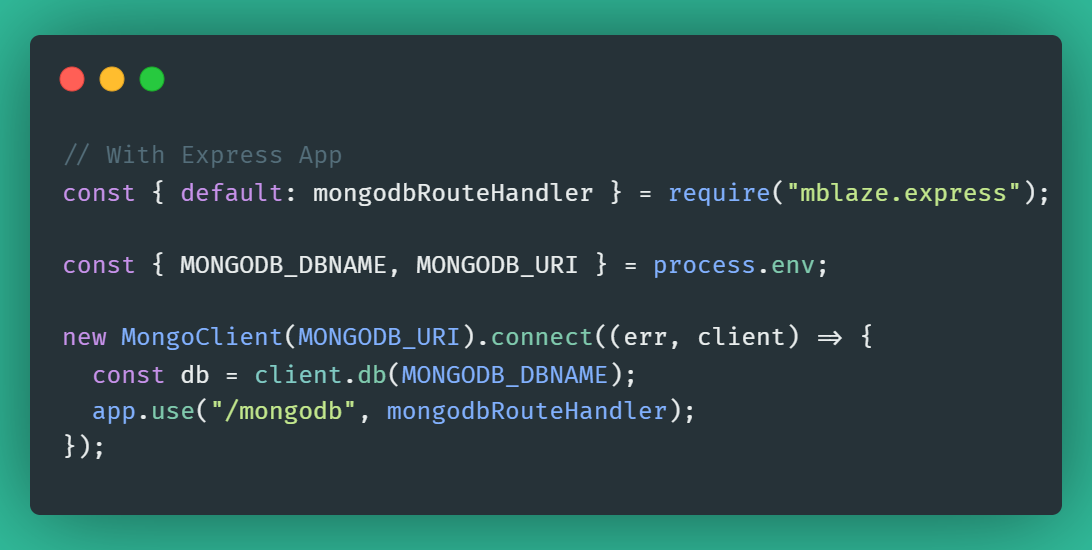This package is a middleware supposed to be used in Tandem with Client Side MBlaze SDKs, together, they are supposed to make MongoDB-based development much more like Firestore.
Get to know a little about the project.
Sets up a single route (A lot like a GraphQL server) on your server, usually at /mongodb responsible for handling calls from the client SDK for CRUD operations.
Note: There is a peer dependency of mongodb, so make sure you have version >=4.9.0 installed in your express project before using the middleware.
npm i --save mblaze.express mongodb
# or
yarn add mblaze.express mongodbconst { default: mongodbRouteHandler } = require("mblaze.express");
// or
import mongodbRouteHandler from "mblaze.express";
const { MongoClient } = require("mongodb");
new MongoClient(process.env.MONGODB_URI).connect((err, client) => {
if (err) throw err;
const db = client.db(process.env.MONGODB_DBNAME);
// or whatever route you need the op handler on.
app.use("/mongodb", mongodbRouteHandler(db));
});Once the Express middleware setup is done, start your server and go to the client, follow the steps here to connect your client app to the MongoDB op handler.
The Postman Collection with examples for all currently supported operations can be found here.
If you're not using mongodb directly and instead using mongoose for your operations already in your project, you can retreive the db instance from the mongoose connection object.
await mongoose.connect(...);
const db = mongoose.connection.db;
app.use("/mongodb", mongodbRouteHandler(db));Note: Make sure the connection is already established before extracting, otherwise the value of db would be undefined.
You can specify security rules for your collections while instantiating the route handler.
app.use("/mongodb", mongodbRouteHandler(db, securityRules));The Security Rules take the form of an object with the following structure:
SecuityRulesObject = {
read: boolean | (Async)Function; // get or list
write: boolean | (Async)Function; // create or update or delete
// Or more granular
get: boolean | (Async)Function;
list: boolean | (Async)Function;
create: boolean | (Async)Function;
update: boolean | (Async)Function;
delete: boolean | (Async)Function;
// Or even collection-level granular
[collectionName]: {
get: boolean | (Async)Function;
list: boolean | (Async)Function;
create: boolean | (Async)Function;
update: boolean | (Async)Function;
delete: boolean | (Async)Function;
}
}The precedence order is most granular to least granular.
I.E: For a get operation on the projects collection
const securityRules = {
read: true,
projects: {
get: false, // This will be considered
},
};The Function to assess the read takes the following arguments:
const securityRuleFunction = (args) => {
const {
req, // The Express request, in case cookies or headers need to be verified
operation, // The operation being performed. get | list | create | update| delete
collection, // The collection the op is being performed on
id, // Only in case of get, create, update and delete operations
newResource, // Data after the document will be modified, only for create and update operations
resource, // The currently existing data, only for get, update and delete ops
filters, // Only in case of 'list' operations
} = args;
return true or false;
}
const securityRules = {
get: securityRuleFunction,
list: securityRuleFunction,
...
}One of the things that makes MongoDB great is transactions.
Note: Make sure the MongoDB database you're using has replica sets, MongoDB only supports transactions on replica sets.
To enable transactions with MBlaze, update the initializer statement:
// In case of mongoose
await mongoose.connect(...);
const db = mongoose.connection.db;
app.use("/mongodb", mongodbRouteHandler(db, securityRules, mongoose.connection));
// In case of mongodb Node.js driver.
new MongoClient(MONGODB_URI).connect((err, client) => {
const db = client.db(MONGODB_DBNAME);
app.use("/mongodb", mongodbRouteHandler(db, securityRules, client));
})Then in order to use transactions for your operations, simply make a request with an array of operations (Only writes supported, except for the read operations that happen internally) instead of a single operation object.
POST /mongodb
body: [
{
collectionName: 'projects',
id: 'project1',
operation: 'delete'
},
{
collectionName: 'tasks',
id: 'task1',
operation: 'update',
newData: {
'field.nestedField.nestedValue': 'updated_value'
}
}
]
The above operations will automatically be run as a transaction. All transaction operations are subject to the same security rules as regular operations.
In many cases you would want to log the operations coming in and out of MBlaze on the server (To forward those logs to a service like Google Cloud Logging for analytics and assessment), you can turn on audit logs in MBlaze by setting the following environment variable:
MBLAZE_ENABLE_AUDIT_LOGS=trueAudit Logs from MBlaze contain the operation name and the request body.
